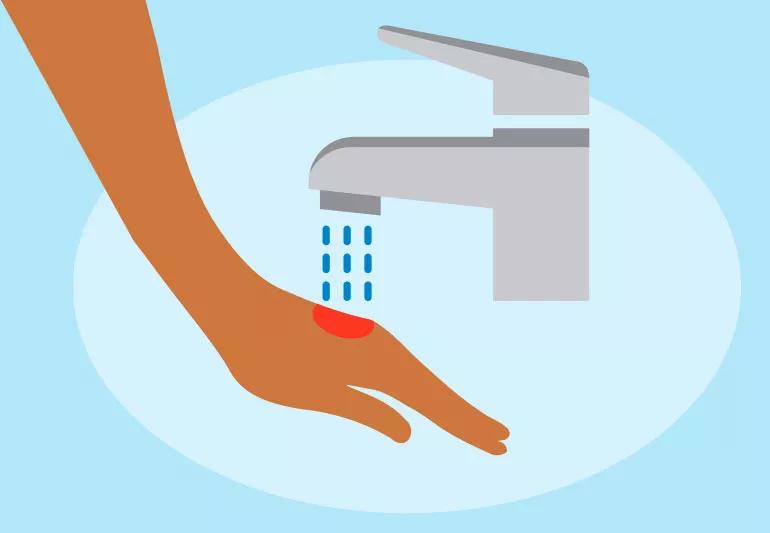Advertisement
Ice (and icy water) can actually make a burn worse, not better

You feel a splash of boiling water, bump the edge of the hot stovetop or accidentally brush your ear with your curling iron. Ouch! When you feel the heat of a burn, your first instinct might be to cool it down — and the faster, the better.
Advertisement
Cleveland Clinic is a non-profit academic medical center. Advertising on our site helps support our mission. We do not endorse non-Cleveland Clinic products or services. Policy
But should you put ice on a fresh burn?
No.
Resist the urge to run to the freezer for an ice cube. Ice on a burn might seem like a good idea, but it can damage your skin. “Even ice-cold water can damage tissues and increase your risk of infection,” says urgent care physician Allan Capin, MD.
There’s a better way to handle a burn that won’t further traumatize your skin. Dr. Capin describes different types of burns and what to do to cool the heat, help the wound heal and minimize scarring.
Ice or very cold water on a burn decreases blood flow to the burnt area, which can reverse the healing process. According to Dr. Capin, the application of ice numbs the burn, which can lead to frostnip, a dangerous precursor to frostbite.
An ice burn is a bigger risk than you might think. “Because the skin is already damaged from the heat burn, you may not feel that the ice is making your skin too cold,” he adds. “That can lead to permanent blood flow problems.”
So, what should you do for a burn instead of ice or icy water? That depends on how bad your burn is.
A minor burn, also called a first-degree burn, is warm, red and painful, but there’s no blistering. You can get a first-degree burn from touching a hot object or getting splashed with a hot liquid. A sunburn with no blisters also falls into this category.
So, should you put ice on a minor burn? Dr. Capin says no.
Here’s how to ease the pain of a first-degree burn:
Get medical attention for a first-degree burn if it:
Advertisement
Even a first-degree burn can become infected, so if your burn starts taking a turn for the worse, go to urgent care or the emergency room. Symptoms to watch for include:
But here’s one thing that isn’t usually a cause for concern: Dr. Capin says the burned skin may turn a bit darker as it heals — and that’s just part of the healing process. With a minor burn, it usually isn’t anything to worry about.
A burn that causes a blister is a second-degree burn, and it’s more serious than a minor (first-degree) burn.
Here’s what to do (and not do) when you have a second-degree burn:
Advertisement
Second-degree burns are at risk of tetanus. If it’s been a while since your last tetanus shot, your healthcare provider may want to give you one.
If your skin is blackened or the burn goes down to the bone, you have a third-degree burn. This is a medical emergency, Dr. Capin says. Go straight to the emergency room.
A first- or second-degree burn may not seem like such a big deal. But burns are prone to infection, and second-degree burns usually leave a scar.
“Even if it’s a minor burn, it’s a good idea to go to urgent care,” Dr. Capin advises. “The right treatment will prevent damage to your skin and minimize the scar that’s left behind.”
Advertisement
Learn more about our editorial process.
Advertisement

Moisturize often, take oatmeal baths, use Epsom salts and follow a healthy diet to help reduce your symptoms

Adding a little milk to your bath can leave your skin smooth, silky and refreshed

Wear properly fitted shoes, break them in ahead of time and wear moisture-wicking socks

Topical treatments — and even some cosmetic procedures — may help reduce the appearance of this crinkled-paper look

Ferulic acid can help make other antioxidant products more powerful

You’re putting your skin at risk of sunburn and even skin cancer when you pour on the beer

Mineral sunscreens have a heavier texture to create a physical barrier, while chemical sunscreens are lighter and use a chemical reaction to prevent UV damage

Deal with dry skin by preserving your skin’s moisture, using moisturizing products and taking preventive action

Focus on your body’s metabolic set point by eating healthy foods, making exercise a part of your routine and reducing stress

PFAS chemicals may make life easier — but they aren’t always so easy on the human body

While there’s little risk in trying this hair care treatment, there isn’t much science to back up the claims